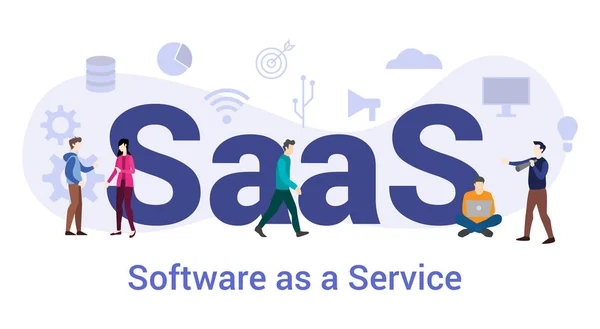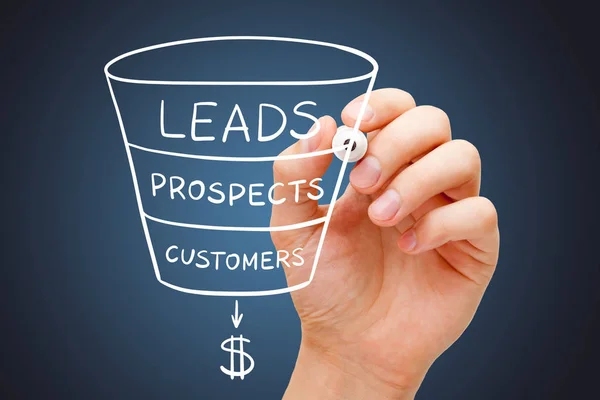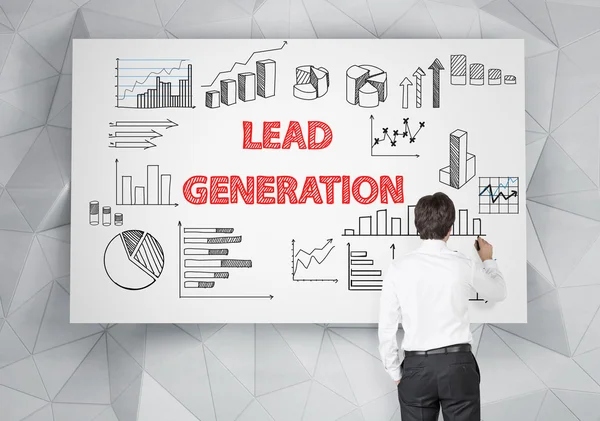Finding the right prospects for your SaaS business is not the easiest task. This niche is pretty competitive, and it has many nuances. So, you need to create a smart lead generation plan for SaaS.
Traditional methods might not be as effective. You should combine different approaches to achieve top results.
Keep reading and learn about the most influential tactics for 2025!
Table of Contents
What Is Lead Generation for SaaS
Lead generation for SaaS is a process of recognizing and attracting potential clients. You find individuals or businesses who might become paying users of your products.
SaaS companies depend on subscription-based revenue models. So, the quality and consistency of leads are more important than in traditional sales models.
The main goal of this activity is to generate interest from the right prospects. Zig Ziglar, an American author and motivational speaker, said
“You are out of business if you don’t have a prospect.”
You need to build a strong strategy to create a predictable and scalable pipeline of potential customers.
Here are a few benefits a good lead generation system can offer you:
- Consistent revenue growth;
- Shorter sales cycle;
- Improved client quality;
- Lower CAC;
- Decisions based on data;
- Higher brand awareness.
In general, it is a long-term investment in your business success.
Key Components of Lead Generation for SaaS
It’s not enough to just develop a good product when you work in the SaaS niche. You also need a flow of potential customers discovering and signing up for your solution. So, smart lead generation for SaaS is a necessity.
Here are the main components that make this activity effective and sustainable.
Ideal Customer Profile
You can’t attract quality prospects without first knowing who your ideal customers are. The ICP defines the types of companies that will get the most value from your product.
ICP elements include
- Industry;
- Company size;
- Annual revenue;
- Tech stack;
- Geographic location;
- Pain points.
A precise client profile helps you avoid wasted budget and ensures you reach the right people.
Converting Website and Landing Pages
Your site is usually the first impression of your business. It needs to convert traffic into leads.
Key features every good website should have are
- Clear headline and subheadline;
- CTA buttons;
- Trust signals;
- Mobile optimization;
- Live chat or chatbots.
Another important aspect is building landing pages. You should build unique pages for each campaign that feature focused messaging and minimal distractions.
Search Engine Optimization
SEO is the foundation of inbound lead generation. A strong plan helps your target audience discover you naturally when searching for solutions.
You should concentrate on keyword variety and on-page optimization. Mobile responsiveness, security, and other technical aspects matter a lot as well.
Another important component is backlinks. They help you build credibility and trust.
Paid Channels
Paid acquisition helps you grow faster if you approach it properly. These channels allow you to reach high-intent audiences and test messaging.
The main channels you can use are
- Google ads;
- LinkedIn ads;
- Facebook and Instagram;
- Retargeting.
Lead Magnets
Sometimes, users aren’t ready to sign up for your solution. However, they may want to exchange their email for useful content. That’s where lead magnets are useful.
These magnets segment your audience by interest. It allows you to trigger automated follow-ups and increase the chances of conversion later.
Nurturing Process
The next essential part of the lead generation system is nurturing. Once a prospect enters your CRM, you have to build trust with them.
The best nurturing practices include
- Drip campaigns;
- Behavior-based triggers;
- Personalization;
- Specific CTAs.
These activities give users a logical next step until they’re ready to convert.
CRM and Marketing Automation Tools
The right infrastructure is also a basis of SaaS lead generation. You need a CRM for tracking relationships and automation tools, such as sales engagement software, to simplify follow-up.
Your tech stack helps marketing and sales teams work in sync. So, each prospect receives timely and relevant communication.
Analytics
The last component of any effective strategy is analytics. You should continuously evaluate performance and test improvements to increase ROI. Focusing on ways to increase conversion rate can provide valuable insights that enhance overall results.
The key points to measure are
- Traffic sources;
- Conversion rates;
- CPL and CAC;
- Content performance.
You can use this data to test new copy, CTAs, and pricing offers. It allows you to focus on tactics that actually work.
SaaS Lead Generation Funnel
The next concept you should understand is the SaaS lead generation funnel. It’s a systematic process that directs potential clients from awareness of your product to becoming qualified leads.
Here are the specifics of each stage of the funnel.
| Funnel Stage | Goal | Key Activities |
| Awareness | Attract traffic and build brand | Content marketing, SEO, paid ads |
| Interest | Engage and educate visitors | Lead magnets, webinars, email signups |
| Consideration | Nurture leads to MQLs | Email workflows, product comparisons |
| Intent | Show product value | Demos, free trials, case studies |
| Evaluation | Convert MQLs into SQLs | Sales outreach, onboarding assistance |
| Decision | Close the deal | Pricing pages, live demos, incentives |
An optimized funnel helps you build useful connections that move prospects forward. You have to analyze performance at each stage and adjust your messaging based on this data.
Top Lead Generation Strategies for SaaS
You already know about the importance of lead generation for SaaS businesses. Companies in this sector need an effective strategy to attract and convert prospects into paying clients.
This niche is pretty specific, so we gathered the main tactics you can try below.
Content Marketing
Content marketing is an important element of inbound lead generation, just like SEO. You need to create valuable and relevant pieces that draw potential customers organically.
Buyers usually do some research before making SaaS purchasing decisions. Publishing educational materials helps them make choices and subtly guides them toward your product.
Some of the content you can create for that purpose includes
- Blog posts;
- Tutorials;
- Guides;
- eBooks;
- White papers;
- Videos.
It’s important to target relevant keywords and showcase how your product solves real problems through these pieces.
Another strategy might include SEO content that helps boost authority in search engines. Experts like LinkBait.ai urge websites to publish content that attracts both traffic and backlinks.
However, much of this content has been written by AI, and it can often feel robotic and generic, which is why it’s important to focus on AI writing that feels human to make it more engaging and authentic.
This can lead to future ROI after authority and rankings improve.
ABM
The next method you can try is account-based marketing. It’s a highly targeted approach that aligns marketing and sales to concentrate on specific accounts.
The main ABM tactics are
- Targeted account lists;
- Customized emails and landing pages;
- Multi-channel engagement.
You use personalized outreach and campaigns to achieve high engagement and conversions.
This strategy focuses on companies that are a strong fit for your product. When considering how to price a product, understanding these target accounts can help tailor your approach more effectively.
Partnerships and Referral Marketing
Partnerships and referrals help you extend your reach. You can use others’ audiences and networks.
Most people trust recommendations from peers and partners more than advertisements. So, collaborations with complementary SaaS tools or affiliates give you access to new quality leads.
Also, you can try customer referral programs. Offer discounts or rewards for successful referrals. It will help you earn more interested prospects.
Paid Search and PPC
PPC advertising is another effective tactic. It helps you appear at the top of search results when users actively look for solutions.
Users who click on paid ads often have high purchase intent. So, you can easily drive traffic to dedicated landing pages.
Try to design separate pages for specific CTAs. Also, make sure to test all the ad copies and targeting for improvements.
Another important step is remarketing. It allows you to bring users back if they visited your site but didn’t convert.
Social Media
Social media offers organic and paid options to connect with leads.
These platforms make your brand more approachable. They are especially useful for B2B campaigns because you can target paid campaigns based on job title and interests.
You can share
- Blog posts;
- Product tips;
- User stories;
- Industry news.
Also, try combining this content with paid campaigns and interactive elements. It will help you boost engagement and traffic.
Emailing
Email marketing is perfect for consistent nurturing. It’s especially useful when your SaaS products require more education or a longer process of making decisions.
Some of the methods you can use for emailing are
- Lead nurturing sequences;
- Personalized messaging;
- Product announcements;
- Conversion triggers.
This approach helps you educate prospects and prompt action without being intrusive.
Live Events
Hosting or participating in live events is another useful tactic. It helps you build authority and trust.
Webinars and live events offer a platform to demonstrate your product and answer questions live. These experiences make your brand relatable and create interactive touchpoints.
Some of the activities you can try are
- Educational webinars;
- Product demos;
- Industry conferences.
Also, make sure to follow up after these events. Send recordings and offers to attendees and registrants.
Free Trials
You can let users experience your product firsthand to convert interest into action.
People are more likely to buy your offering when they can try before committing. A good free trial or freemium version helps you build familiarity and showcase value.
To get the most out of this strategy, make sure to provide
- Clear onboarding;
- Email support;
- Tutorials;
- In-app messaging.
Plus, you can offer discounts or added features to encourage conversion.
Retargeting through Ads
The last tactic we want to highlight is retargeting. It’s a strategy of bringing users back after they’ve shown initial interest.
Most people don’t convert on their first visit. Retargeting allows you to keep their attention by offering personalized ads on different platforms. The main goal is to analyze their previous behavior.
Focus on visitors who viewed
- Pricing;
- Demos;
- Sign-up pages, etc.
Deliver different messages depending on how far a user is in the funnel. Also, try to include limited-time offers to drive action.
Conclusion
An effective lead generation strategy is a necessity for any SaaS business. It helps you grow your revenue and attract more quality clients. This niche is pretty specific, and traditional methods don’t always work.
The top tactics you can use to succeed are
- Content marketing;
- ABM;
- Partnerships;
- Paid search;
- Social media;
- Email marketing;
- Live event;
- Free trials;
- Retargeting.
Make sure to create a structured lead generation funnel and constantly track the impact of each campaign you start.


